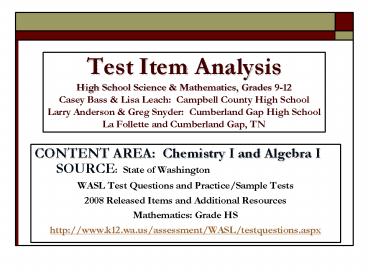Test Item Analysis High School Science - PowerPoint PPT Presentation
1 / 10
Title:
Test Item Analysis High School Science
Description:
Test Item Analysis. High School Science & Mathematics, Grades 9-12 ... Larry Anderson & Greg Snyder: Cumberland Gap High School. La Follette and Cumberland Gap, TN ... – PowerPoint PPT presentation
Number of Views:353
Avg rating:3.0/5.0
Title: Test Item Analysis High School Science
1
Test Item AnalysisHigh School Science
Mathematics, Grades 9-12Casey Bass Lisa Leach
Campbell County High SchoolLarry Anderson
Greg Snyder Cumberland Gap High SchoolLa
Follette and Cumberland Gap, TN
- CONTENT AREA Chemistry I and Algebra I SOURCE
State of Washington - WASL Test Questions and Practice/Sample Tests
- 2008 Released Items and Additional Resources
- Mathematics Grade HS
- http//www.k12.wa.us/assessment/WASL/testquestions
.aspx
2
Overview
Step II Standards Alignment Connections to
Curriculum Framework Content Clarification Strand
Map
- Step I Item Analysis
- Standardized Test Item
- Test Item Type
- Test Item Structure
- Embedded Content and Skills
Step III Instructional Alignment Lesson Plan
3
Step I Standardized Test Item
State of Washington WASL Test Questions and
Practice/Sample Tests 2008 Released Items and
Additional Resources Mathematics Grade HS
http//www.k12.wa.us/assessment/WASL/testquestion
s.aspx
Overview Page
4
Step I Test Item Type and Structure
- Multiple Choice
- Visual Stimulus A tissue box with a tissue
protruding from it. - Stem A tissue can be 0.000075 meters thick.
Which expression represents this in scientific
notation? - Distractors A, C, and D. Answer A is a
distractor because it has an incorrect exponent.
C and D are distractors because these answers
convey incorrect decimal placements. - Correct Answer Choice Answer B
- What makes this the correct choice? It displays
the correct scientific notation form with correct
decimal placement and exponent.
Overview Page
5
Step I Embedded Concepts Process Skills
- Concepts and Big Ideas
- Proper Use of Appropriate Notation, Real Numbers
- Process (Inquiry or problem solving) Skills
- Scientific Notation, Exponents, Placement of
Decimals, Significant Figures - Webbs Depth of Knowledge (DOK) Levels
- Skill/Concept
- Strategic Thinking
Overview Page
6
Step II Connections to State
Curriculum Framework
- Science
- CLE 3221.3.3 Explore the mathematics of
chemical formulas and equations. - Embedded Math
- CLE 3221.MATH.1 Understand the mathematical
principles associated with the science of
chemistry - CFU 3221.MATH.1 Use a variety of appropriate
notations (e.g., exponential, functional, square
root). - CFU 3221.MATH.9 Select appropriate units,
scales, and measurement tools for problem
situations involving proportional reasoning and
dimensional analysis.
Overview Page
7
Step II Connections to State Curriculum
Framework
- Math
- CLE 3102.2.1 Understand computational results
and operations involving real numbers in multiple
representations. - CFU 3102.2.5 Perform operations with numbers
in scientific notation (multiply, divide,
powers). 3102.2.6 Use appropriate technologies
to apply scientific notation to real-world
problems.
OverviewPage
8
Step II Content Clarification
- Click here to view the Science Content
Clarification Worksheet. - Click here to view the Math Content Clarification
Worksheet.
Overview Page
9
Step II Atlas of Science Literacy
Overview Page
Click here to Navigate to the Map
10
Step III Instructional Alignment
- Click here to view the completed lesson.
Overview Page































